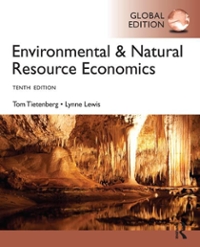Question
Cathy spends 2 hours every day in commuting from home to work and then back (1-hr each way). Her utility over consumption (C), hours worked
Cathy spends 2 hours every day in commuting from home to work and then back (1-hr each way). Her utility over consumption (C), hours worked (H), and hours spent in commute (S) is given by:
U(C, H) = C - 1.5(H + S)2
Assume that (a) price of C is $1 (b) S = 2. For simplicity, assume that there are no other costs (e.g., ticket costs, parking fee) associated with commuting. Spending more than 12 hours in work reduces worker productivity to zero, so we assume that
0H12
(a) (1 mark) Is Cathy's preference monotone in C and H? Explain.
(b) (1 mark) Draw an indifference curve in (H, C) space that yields U = 32. Make sure to
Plot hours worked (H) in horizontal axis and (C) in vertical axis.
Plot two points: one where H = 0 and another where H = 12.
(c) (2 marks) Cathy's income is hourly wage (w) times the hours worked (H). Suppose w = $30 per hour. How many hours would Cathy work to maximize her utility? How much C will Cathy consume? Assume that Cathy has no other sources of income.
(d) (3 marks) During the pandemic, Cathy has worked from home. Research on working from home (WFH) shows that individuals typically spend about 50% of the time saved (from commuting) in working and 50% in leisure activities.
(i) (1 mark) We model working from home as a reduction of S from S = 2 to S = 0. How much of those 2 hours saved does Cathy spends in work? Does it match with the research finding?
(ii) (2 marks) To save costs, Cathy's employer is considering a wage cut for its employees working from home. Cathy will be prepared to accept a cut in hourly wages (w) if w does not fall below ____________________ (write up to two decimal places). [Note: Cathy accepts a wage cut as long as her utility does not fall below pre-WFH utility]
(e) (2 marks) Wage cuts have been strongly resisted by the employees as they realized that they need extra space to work productively from home. For example, it will cost Cathy R dollars more per day. Cathy will opt for WFH if and only if her utility from doing so is higher than her utility under the status quo (with 2 hours' commuting time). This means Cathy will opt for WFH if and only if R is less than ___________________. Explain.
[Assume Cathy opts for WFH if she is indifferent between WFH and commuting]
Step by Step Solution
There are 3 Steps involved in it
Step: 1

Get Instant Access to Expert-Tailored Solutions
See step-by-step solutions with expert insights and AI powered tools for academic success
Step: 2

Step: 3

Ace Your Homework with AI
Get the answers you need in no time with our AI-driven, step-by-step assistance
Get Started


